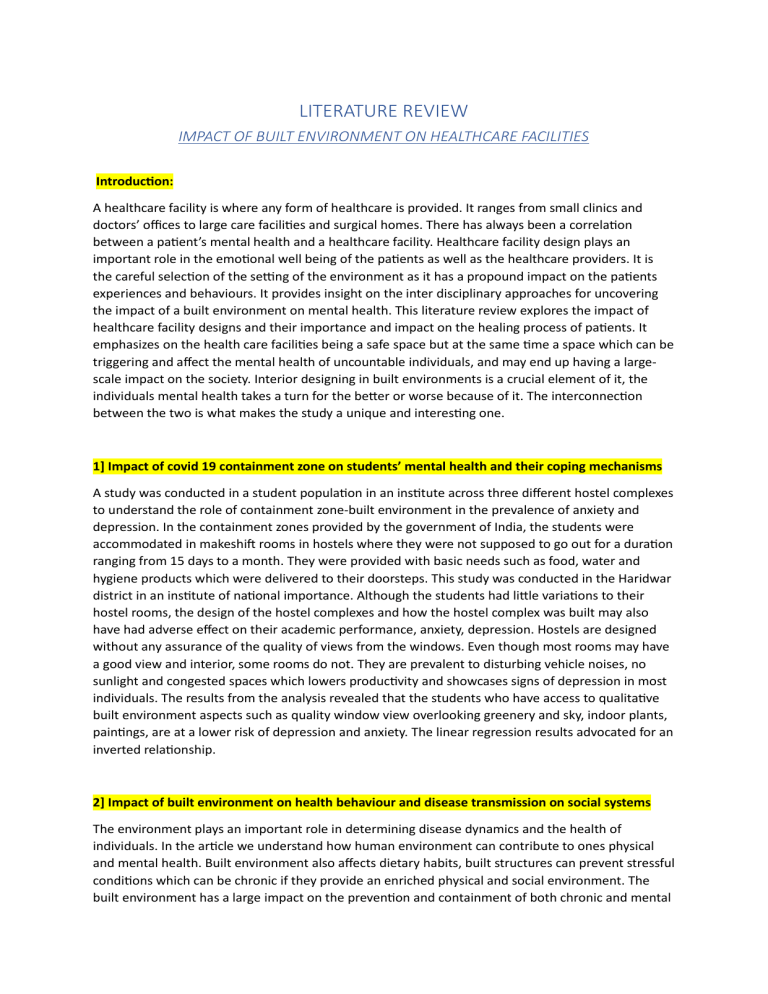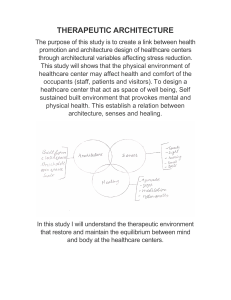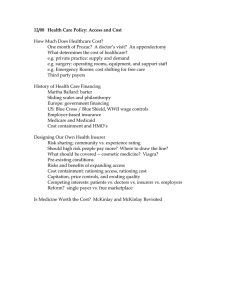
LITERATURE REVIEW IMPACT OF BUILT ENVIRONMENT ON HEALTHCARE FACILITIES Introduction: A healthcare facility is where any form of healthcare is provided. It ranges from small clinics and doctors’ offices to large care facilities and surgical homes. There has always been a correlation between a patient’s mental health and a healthcare facility. Healthcare facility design plays an important role in the emotional well being of the patients as well as the healthcare providers. It is the careful selection of the setting of the environment as it has a propound impact on the patients experiences and behaviours. It provides insight on the inter disciplinary approaches for uncovering the impact of a built environment on mental health. This literature review explores the impact of healthcare facility designs and their importance and impact on the healing process of patients. It emphasizes on the health care facilities being a safe space but at the same time a space which can be triggering and affect the mental health of uncountable individuals, and may end up having a largescale impact on the society. Interior designing in built environments is a crucial element of it, the individuals mental health takes a turn for the better or worse because of it. The interconnection between the two is what makes the study a unique and interesting one. 1] Impact of covid 19 containment zone on students’ mental health and their coping mechanisms A study was conducted in a student population in an institute across three different hostel complexes to understand the role of containment zone-built environment in the prevalence of anxiety and depression. In the containment zones provided by the government of India, the students were accommodated in makeshift rooms in hostels where they were not supposed to go out for a duration ranging from 15 days to a month. They were provided with basic needs such as food, water and hygiene products which were delivered to their doorsteps. This study was conducted in the Haridwar district in an institute of national importance. Although the students had little variations to their hostel rooms, the design of the hostel complexes and how the hostel complex was built may also have had adverse effect on their academic performance, anxiety, depression. Hostels are designed without any assurance of the quality of views from the windows. Even though most rooms may have a good view and interior, some rooms do not. They are prevalent to disturbing vehicle noises, no sunlight and congested spaces which lowers productivity and showcases signs of depression in most individuals. The results from the analysis revealed that the students who have access to qualitative built environment aspects such as quality window view overlooking greenery and sky, indoor plants, paintings, are at a lower risk of depression and anxiety. The linear regression results advocated for an inverted relationship. 2] Impact of built environment on health behaviour and disease transmission on social systems The environment plays an important role in determining disease dynamics and the health of individuals. In the article we understand how human environment can contribute to ones physical and mental health. Built environment also affects dietary habits, built structures can prevent stressful conditions which can be chronic if they provide an enriched physical and social environment. The built environment has a large impact on the prevention and containment of both chronic and mental health diseases in humans and animals. The effects of built environment can be directed that is affecting the environmental quality or it can be indirect by influencing behaviours that impact disease transmission and health. The impact of this happens at many scales, from individual to the society and from the design of the plates we eat from to the design of the city. Many chronic diseases stem from heightened stress levels. The built environment may reduce the amount of stress by changing social interactions. However not all animals and humans require the same number of social interactions in built environments to reduce stress, this should be taken into consideration when fitting the social preferences and structure of the species occupying the built structure. Hence the article makes us understand how built structures help determine the complexity of a chronic illness and impacting in health behaviour of both animals and humans. 3] Healing environment correlated with patients’ psychological comfort Nowadays physical as well as non-physical environments are considered as potential contributors to a person’s health and recovery process. This study aims at understanding the relationship between the qualitative aspect of a healing environment and the patient’s psychological comfort. Interior appearance, comfort and control, views and privacy are the four major contributors to a patient’s satisfaction in a healing environment. A negative correlation between age education and patient satisfaction was revealed. An increasing number of evidences exist stating that the indoor environment has a major impact on the patients heling. Ulrich set up controlled experiments at a hospital which proved that a patient recovering from disease or surgery took fewer pain killers was exposed to a view through a window rather than bare hospital walls. The conditions of a hospital setting which play a role in the patients healing process should include safety, artwork, ergonomics, appropriate lighting, a good external view, adequate furniture and a homely environment. Studies show that if a patient’s rooms are changed and modified according to their psychological needs the faster, they are able to recover as it will positively affect the outcome for patients, decreasing their length of stay in the hospital. A few theories aimed to reveal that the relation between a person’s indoor environment and level of satisfaction that is stress free and helps patients with not only receiving medical care but also receiving a friendly environment with no additional stress. The POE tools used for the comfort level of the patients can be ensured to make sure the quality of the designed environment is catering to the psychological needs of the patients to make their healing process a speedy one. Appropriate interior design with the tested comfort factors results in improved patient satisfaction and ward performance leading to an increase of the indoor built environment quality. A broader disciplinary approach that gathers knowledge from environmental psychology and sociology with evidence-based design improved understanding of hoe social spaces are utilized and appreciated by the family of the patients, and also how these provisions contribute to their social well being greatly. Additionally, this study also suggests that post occupancy is an important tool to determine the quality of the indoor environment and provides a guideline for building useful techniques for designer’s that variations in the indoor physical designs may positively impact the patient’s satisfaction level. Conclusion In the realm of healthcare institutions and designs the integration of carefully selected objects, colours placements and the overall interior design of the built environment has a substantial impact on both patients and healthcare providers. The studies reviewed that these things offer valuable insights in the effects of these deigns which help in the recovery, healing, stress reduction and well being of the patients. Collectively these studies showcase the impact and significance of the healthcare facility design which promote healing recovery and stress reduction. As the field evolves, the integration of immersive environment holds the potential to transform healthcare facilities into spaces that provide comfort, resilience and optimal care experiences. References: https://www.ncbi.nlm.nih.gov/pmc/articles/PMC9759457/pdf/main.pdf https://www.researchgate.net/profile/FouadMahmood/publication/337349213_Healing_environment_correlated_with_patients'_psychological_ comfort_Postoccupancy_evaluation_of_general_hospitals/links/607078d692851c8a7bb6d576/Healingenvironment-correlated-with-patients-psychological-comfort-Post-occupancy-evaluation-of-generalhospitals.pdf https://royalsocietypublishing.org/doi/pdf/10.1098/rstb.2017.0245




